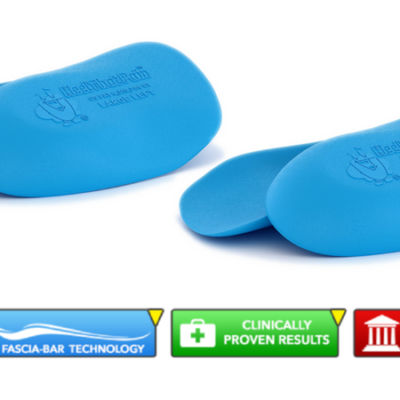Heel and Foot Pain Treatments
Is heel or foot pain slowing you down? When it gets bad, foot pain makes it harder to work, exercise, run errands, and enjoy family time.
Making the right choices when it comes to treating your heel pain can have significant consequences in how fast you heal, whether additional complications arise, and how much time and money you spend in the process.
The good news is, most heel pain is easy to treat using conservative at-home methods. Keep reading to learn more about how to find a treatment that’s right for you, top heel pain treatments, how to get your condition diagnosed.
Choosing the Best Heel or Foot Pain Treatment
Which treatment is right for you? If you’re dealing with heel pain for the first time, most podiatrists recommend conservative care (more information below!). However, if heel pain has become a chronic problem, or your pain hasn’t responded to conservative care, you may need to consider medical care or even surgery.
The treatments you choose will depend on the cause and location of your pain, how long you’ve been suffering from pain, your doctor’s recommendations, and your lifestyle. It’s important to consider a variety of factors before you choose a treatment:
Identify Proven Treatment Methods from Multiple Sources
Approach your research into potential foot pain treatments with the same diligence you’d approach buying a new car or house. Take your advice from scientific journals, medical websites, and reviews from real people who have used a particular product or method. Don’t be swayed by a smooth sales pitch or big promises.
Don’t Discount At-Home Remedies for Foot Pain
Remember, most cases of foot pain can be resolved simply, with at-home, conservative methods. While foot pain can be scary, jumping directly to medical intervention can be both painful and costly. Depending on your unique situation and the severity of your symptoms, start with the most conservative and proven methods of treatment you can find. If you aren’t experiencing relief, it may be necessary to consider medical treatments.
Give It Time
Heel pain usually is the result of strain and injury that has compounded over time, resulting in injury. This means that treatment and healing will take some time as well. Stay dedicated to proven treatment methods, and be patient with your chosen course. If your symptoms aren’t improving as time goes by (many courses of treatment can take 3-6 months), it’s time to see a doctor for potential medical interventions.
Conservative Foot & Heel Pain Treatments
The most common and effective foot pain treatments recommended by doctors for a new case of plantar fasciitis include the following:
Rest
The first step towards treatment is rest. Refrain from putting any additional stress on the inflamed or painful area of your foot to allow your arch and heel to repair itself without reinjury.
Avoid running long distances or participating in any exercise that puts repetitive pounding and weight on the heel of the foot. If there are any recreational or occupation-related activities that may be contributing to stress on your foot, it is best to limit or stop those activities until you have fully healed.
Icing
Icing can help pain by numbing the nerves, and reducing inflammation and swelling in the foot and heel. Ice twice a day, for 10-15 minutes, using indirect cold (wrap a bag of ice in a washcloth, or try Ice Slippers that hold the ice in place).
Click here to get best-selling Ice Therapy Slippers.
Stretching
While it might sound simple, stretching can be extremely effective for heel pain. Often, heel pain happens as a result of inflexible tendons, ligaments, and muscles in the foot and heel. By lengthening, stretching, and strengthening these muscles and ligaments you can help your foot work more effectively as well as breaking up scar tissue and adhesions.
NSAIDs
Non-steroidal anti-inflammatory medication, or NSAIDS, like ibuprofen and acetaminophen can help reduce swelling, pain, and tenderness in the heel. Make sure to use these medications sparingly, and never use them in an attempt to “soldier on” with an activity that may cause further damage to your heel.
Orthotic Heel Pain Treatments
In many cases, orthotic devices are the smartest solution for treating heel pain. Well constructed orthotic inserts like can give the heel of the foot the added support it needs to relieve the pain associated with the plantar fascia ligament and around the heel of the foot.
With a high-quality orthotic insert like Heel Seats, acupressure is applied precisely where it is needed as your weight shifts, reducing and preventing pain associated with the heel of the foot.
Heel Seat orthotics are the top heel pain treatment because they:
- Are available in a number of sizes in order to fit your specific needs
- Are just as effective as custom orthotics (but cost much less!) and can be worn with almost any pair of closed-toe shoes
- Are specially researched and formulated to meet strict anatomical specifications
- Move seamlessly with the movements of your foot, allowing you to relieve heel pain and reverse the cause of the heel pain while also making sure not to interfere with your daily lifestyle

Medical Treatments and Heel Pain Surgery
Although 90% of heel pain sufferers find relief with conservative care, the remaining 10% who struggle with chronic heel pain may need to combine home treatment with medical interventions or surgery.
If you struggle with chronic heel pain that doesn’t respond to conservative treatments, it’s time to form a treatment plan with a trusted medical provider. He or she will provide an official diagnosis and work with you choose an evidence-based treatment for your heel pain. If these second-tier medical treatments still do not improve your quality of life, surgery can be an effective last resort to get you back on your feet.
To help your doctor make the best recommendations for medical treatments, prepare for your appointment by documenting and researching your symptoms.
Document Your Symptoms
Before you visit your doctor, take a few minutes to document all the symptoms you’ve been experiencing. Start a document to jot down your thoughts, information about your symptoms, and any articles you find and might want to reference later. This will help give you something to refer back to as symptoms change, when you see a doctor, or when you try different treatment options.
As you write down your symptoms, make sure to note how long you’ve been experiencing them, whether anything in particular makes them feel better or worse, whether one or both feet are affected, how severe the symptoms are, whether they have changed over time, and what you’ve tried so far in treating them.
Research on Your Own
When you’ve made a complete inventory of your foot pain symptoms and the ways they are presenting, take your notes to the research phase. Use reputable sites like Mayoclinic.com or WebMD.com to search for your symptoms, starting with the most severe and working your way down to less noticeable symptoms.
Remember, if your heel pain symptoms are mild or just beginning, you can generally feel confident that home remedies will help. If your symptoms are severe or your research leads you to believe that they may be signs of a break, fracture, or other condition that requires medical intervention, make an appointment with your doctor right away.






